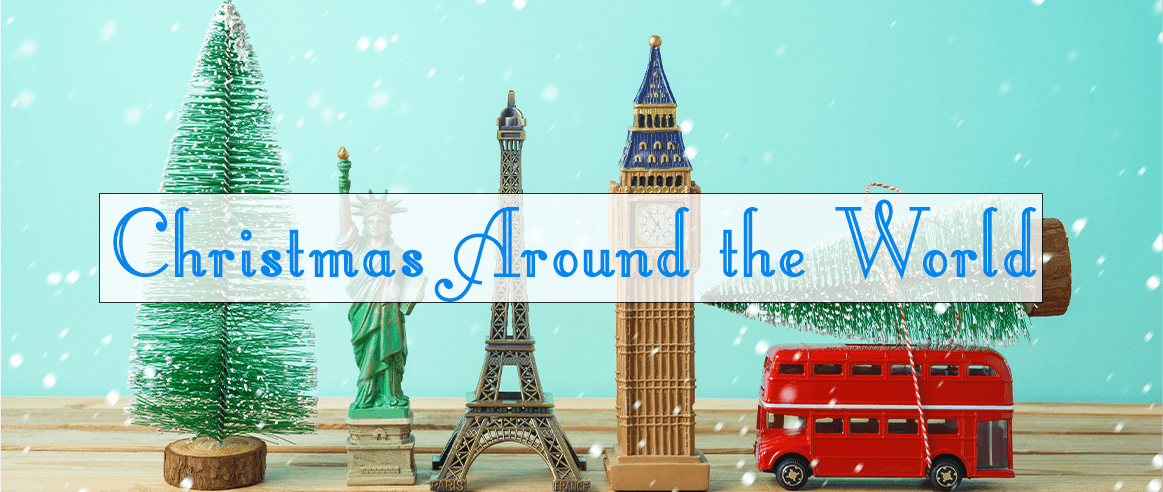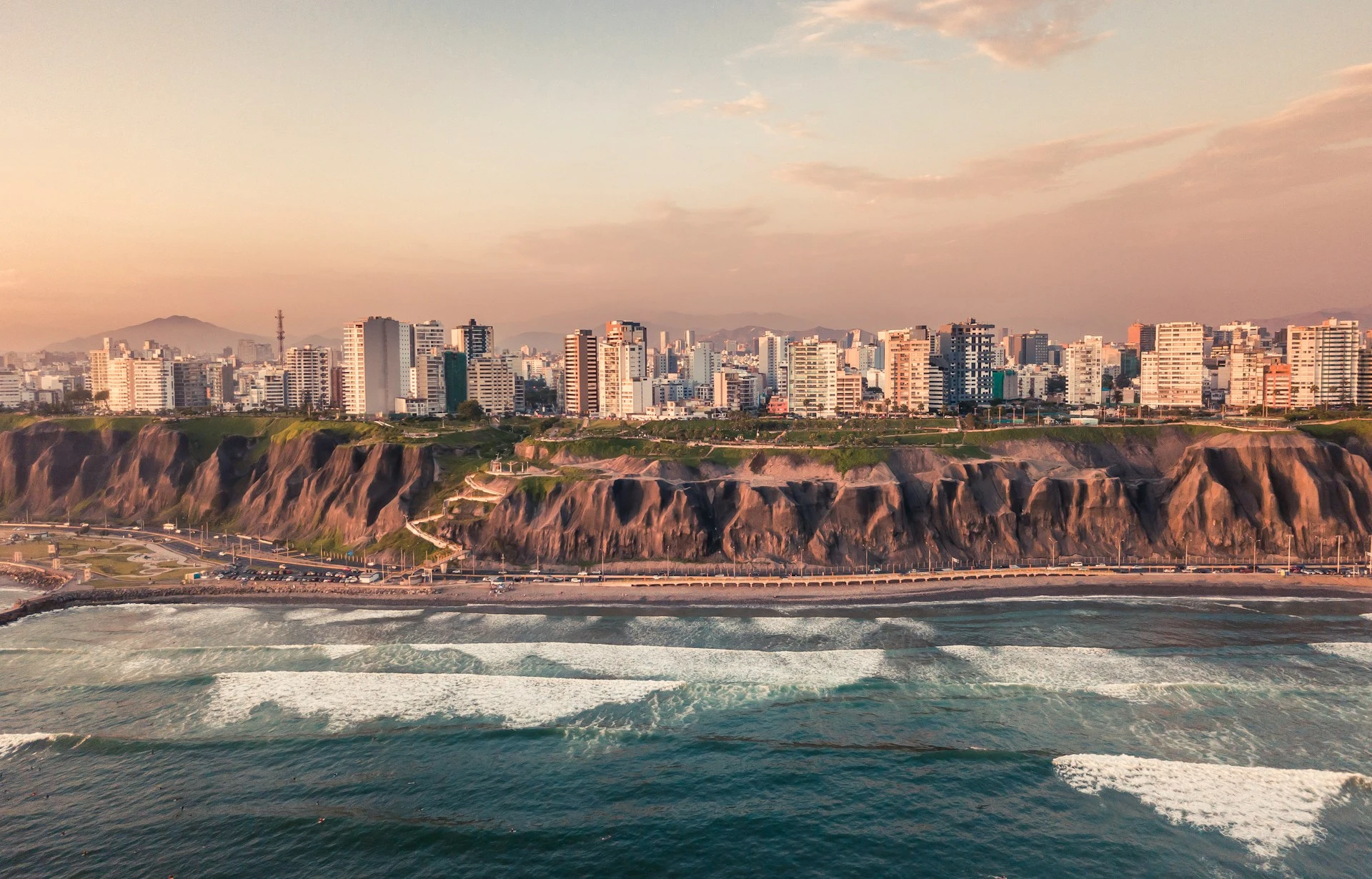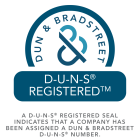Written by Jaden Parker
It’s always so interesting to learn new things. So, I took the time to find out how people all over the world celebrate Christmas. Obviously Christmas isn’t the only holiday celebrated during December, so I’ll be getting to that at the end of this post. Either way, here is how Christmas is celebrated in some countries, letters P through Z!
Peru
Prior to Christmas, people in Peru meet each other to drink hot chocolate and eat panetón (Italian Christmas cake). These events are called chocolatadas! Historically, chocolatadas were a way people shared food with people who were less fortunate. Nacimientos or pesebre (Nativity scenes) are a focal decoration for most households. Occasionally, you will find Peruvian animals like llamas in them. Baby Jesus is typically not added until Christmas Day. Smaller versions of the nacimientos are called retablos, and they are scenes made in a box with two doors on the front of them.
The 10pm mass service on Noche Buena is called Misa de Gallo, or the “Rooster Mass.” Following mass, the main holiday meal is eaten with tamales, salads, roast turkey, and/or fish. During the dinner, people countdown to midnight and exchange gifts. There are fireworks celebrations to kick off the festivities, and people go into the streets to give season’s greetings to their neighbors and friends. Some areas have parades on Christmas Day. The Epiphany on the 6th is also an important holiday for some Peruvians. Those who celebrate it usually exchange presents on this day instead of Christmas. Traditionally, the Rosca de Reyes, or King’s Cake, is eaten.
Philippines
Starting on December 16th, there are nine early morning masses leading to the last one being on Christmas Day. From there, Christmas is celebrated until the Feast of the Three Kings. The Philippines has a lot of western traditions because Christianity was brought to them through missionaries from Portugal and Spain. Thus, they have a “Santa Klaus” and Christmas trees. A purely Filipino tradition, however, is parol, which is a Christmas decoration made from bamboo and cellophane paper to represent the guiding star of the Three Wise Men.
Because there are eight major languages spoken in the Philippines, there are numerous ways to say “Merry Christmas!” At the big Christmas meal on Noche Buena, families have rice cakes, ham, roasted pig, and different types of desserts. Another beautiful Filipino tradition is Santa R-Kayma Klaws. For well over 50 years, Santa R-Kayma Klaws has dressed up as Santa to visit poor children during charity events. He arrives in a giant air-conditioned bus and owns the only reindeer farm in the Philippines.
Poland
For those in Poland who celebrate Christmas, Advent is an incredibly serious religious dedication to Mary. The special masses they hold called roraty are held at dawn to spiritually prepare for the coming of Christ at Christmas. Houses are scrubbed from top to bottom during Advent, and kids hope that Mal̷y Mikol̷aj will leave them presents in their shoes or near the fireplace on the 6th of December. During school, a lot of children also take part in the Nativity Plays (Jasel̷ka), which are occasionally set in modern times.
Christmas Eve, also known as Wigilia, is a major day for Poland because it’s a largely catholic country. On Christmas Eve, the main meal is eaten in the evening called Kolacja wigilijna. Children will watch the sky at night to spot the first star; once the star is seen, presents can be opened and food can be eaten! The meal consists of twelve dishes, each one representing a month of good luck for the next year. Most families avoid meat to pay tribute to the animals who took care of Jesus while he was in the manger. Everyone must have some beetroot soup (barszcz), which can be paired with mushroom dumplings (uszka) or mushroom and cabbage pancakes (krokiety).
Carp’s the main dish of the meal, and some people believe the scales bring good luck. Along with the aforementioned dishes, the table can have herrings, pierogies, or bigos, which is cabbage with bacon and dried plums. Desserts like makowiec (poppy seed roll) and piernik (a cake made of honey) are washed down with kompot z suszu (a drink of boiled dried fruits and fresh apples). Before everyone digs in, they pass around a wafer called an opl̷atek for everyone to take a piece of. It has a picture of Jesus, Mary, and Joseph on it.
Besides Mal̷y Mikol̷aj for Advent, there are other gift-bringers during the holiday season in Poland.
| Region | Name | Meaning |
| Northern/Western | Gwiazdor | The Starman |
| Southern (Śląskie; Małopolskie) | Dziecia̦tko | Baby Jesus |
| Southern | Aniołek; Gwiazdka | Little Angel or Little Star |
| Eastern (Podlaskie) | Dziadek Mróz | Grandfather Frost |
Polish Christmas trees sometimes have a spider web decoration to symbolize the story of the Christmas spider, where a spider is granted the honor of inventing tinsel. Some households break one of the ornaments to scare evil spirits away. The film everyone loves to watch on Christmas Day is Home Alone!, which they call Kevin Sam w Domu—meaning “Kevin Alone in the House.” Finally, children singing carols during the Epiphany is a common sight to see in Poland on the 6th of January.
Portugal
In Portugal, Christmas Eve has the main traditions of the holiday season. Their meal before Missa do Galo is called Consoada. It can range from shellfish and salted cod to boiled potatoes and fried cookies. However, regions different on what sort of desserts they make. Filhós, fried, cinnamon sugared dough, is made with carrots and shaped into round balls in Alentejo, but the Beira Province makes them flat and round with some orange or lemon zest! After church, the children are allowed to open their presents from Pai Natal.
Historically, young men who were a part of compulsory military service would burn whole trees in the church yard, calling the tradition Christmas Madeiro. Even though these services have been out of commission for quite some time, some areas still take part in burning the tree stump.
At the start of January, people go from house to house and sing the Janeiras songs with instrumental accompaniment. If you don’t respond to them coming to your house or don’t have food and drink that is good enough to give them, they will instead sing songs of mockery.
Singapore
Although less than a quarter of people in Singapore are Christians, a lot of people still celebrate the holiday. There’s a “Christmas Wonderland” theme park in Singapore for tourists, and Christmas light displays decorate Orchard Road. St. Andrew’s Cathedral features a life size Nativity Scene, and Christmas trees are decorated with ribbons and teddy bears. Their Christmas dinner is very westernized with roast turkey being the main dish.
Slovenia
There are many special days in December that Slovenians celebrate besides Christmas Eve and Christmas Day. On St. Nicholas Eve (Miklavževanje), Sveti Miklavž visits, and a parade is held for him every year in Ljubljana. Bad children are visited by his scary sidekicks called “trotters,” but good children can get gifts from his helper angels. After that, on either St. Barbara Day on the 8th or St. Lucia’s Day on the 12th, they plant wheat grass for the table decor on Christmas. During the month prior to Christmas, children may be visited by the Three Good Men (tri dobri možje)
In the Postojna Cave near Kranjska Gora, there is a live Nativity scene that takes place every year. The main holiday meal is eaten in the evening of Christmas Eve. This meal could involve any sort of pork dish. Some believe that it’s bad luck to eat chicken at this time. Reasoning? Pigs move forward to eat, but chickens scratch backwards! During this time, the special potica is eaten. A swirled cake with honey, nuts, poppy seeds, and raisins, potica can have different traditional fillings from region to region. Along with Santa (Božicek), Dedek Mraz (Grandfather Frost) can pay children a visit and leave them presents.
Sweden
For the Swedes, St. Lucia’s Day on December 13th is almost a bigger celebration than Christmas itself. It’s celebrated with a young girl dressing up in a white dress with a red sash around the waist. She has a crown of candles on her head to symbolize the meaning of her name, “light.” A Lucia is chosen for the nation, and she is expected to visit old folk’s homes and hospitals and hand out ginger snaps. On this day, many people eat Lussekatts, which are saffron and raisin buns.
On Första Advent, Swedish people make Advent Stars from red paper that are usually seven-pointed. An electric light is put inside them to guide the wise men. This is a tradition from the 1930s. Nowadays, the stars are white and made from straw, wood, paper, or metal.
The Christmas Eve feast is called a julbord, and it’s eaten around lunchtime. Some sort of cold fish must be included, like herring, gravlax, and/or smoked salmon. Along with fish, cold turkey or julskinka can be seen on the julbord with liver pate, pickles, kåldolmar (meat-stuffed cabbage), and revbenspjäll (oven-roasted pork ribs). Desserts are usually an array of sweet pastries. They drink sweet mulled wine called glogg or coffee with it.
As many countries we’ve covered before do, Swedes watch “From All of Us to All of You” on the afternoon of Christmas Eve. Like in Finland, there was a tradition that a Yule Goat watched over the Christmas proceedings as a spirit to make sure things went smoothly. So, between Christmas and New Year’s, men would occasionally dress up as goats and sing songs from house to house. This affair is called Julebukking. Now, the goat is just an ornament on the Christmas tree! Every year, there is a giant straw goat model in Gävle that gets burned down. The first 43 foot tall straw goat was first burned down in 1966, and it has only survived roughly 15 times since then.
Jultomten brings presents with the help of his little Christmas gnomes, the Tomte. People usually do a Secret Santa custom called Julklapp in their neighborhood where they knock on the door of a friend or neighbor and leave a small gift for them. The end of a Swedish Christmas is January 13th. They call it Tjugondag Knut, named after the Danish prince Canute Lavard. On this day, the Christmas tree is taken down and all leftover sweets are finished off.
Switzerland
The Swiss have live Advent calendars that kick off the Christmas season. Each house represents an Advent window and holds a party for the other villagers when it’s their day. They eat a lot of food and drink Glühwein. There are big light displays in the major towns along with giant Christmas markets. In the Bernese Oberland region, they have parades where people wear giant cow bells and make a lot of noise to scare away evil spirits. Similarly in villages around Urnäsch, their parades have people who wear costumes and headdresses. The Kläuse, or people of the parade, sing songs from house to house. Caroling, called “Star Singing,” is also quite popular for children during the holiday season.
Samichlaus delivers gifts on December 6th, but children can also get presents from Father Christmas on the 25th and Befena/ the Three Kings on the Epiphany. For decorating Christmas trees, some households use real candles, which are lit on Christmas Eve and New Year’s Eve.
On Christmas Eve, the main meal is eaten with foods like scalloped potatoes, ham, and fondue for parties! Desserts are often a walnut cake and/or Christmas cookies. Most families have their own cookie recipes.
Ukraine
In July of this year, Christmas was officially declared as a celebration on the 25th of December. Before, it was celebrated on January 7th due to Ukraine’s Orthodox church being historically connected to Russia’s Orthodox church. Some will still celebrate it in January if they can, but now a lot of Ukrainians will celebrate on December 25th. Svyatyi Mykolai—or St. Nicholas—will deliver gifts to Ukrainian children on the 5th, and Grandfather Frost visits on New Year’s Eve. Christmas trees have paper snowflakes and artificial spider webs for the The Christmas Spider story. Fun fact: the song “Carol of the Bells” comes from the Ukrainian carol “Shchedryk.”
Due to the current circumstances in Ukraine, a lot of Ukrainians won’t get to enjoy the Christmas holiday amidst the war with Russia. In a more peaceful time, they would have their Christmas meal on Christmas Eve called Sviata Vecheria. There are usually twelve dishes, each one representing a disciple of Jesus. The main dish is called kutia, which is a sweet wheat porridge. Side dishes could be anything from cabbage rolls (holopchi) and pierogies (varenyky) to Christmas bread (kolach) and whitefish. Another meal is eaten the following day, and dishes can have meat in them for that meal.
Vietnam
Christmas isn’t an official public holiday in Vietnam, but Christmas Eve is widely celebrated. A lot of younger people in Ho Chi Minh like to go to the Catholic Cathedral in the center of the city. People throw confetti and look at the Christmas decor and lights of the department stores and hotels. Although there aren’t many Christians in Vietnam, a decent crowd goes to midnight mass services to watch the Nativity plays. Since Vietnam was once a part of the French Empire, their main meal is called reveillon, too. They also eat the log-shaped chocolate cake for dessert! Vietnamese children can expect presents from Ông già Noel (“Christmas Old Man”).
Zimbabwe
After the Church service on Christmas Day, the people of Zimbabwe go from house to house for a day full of parties. Some people put speakers outside their homes and play some music for those passing by. At the parties, a lot of people show off the new clothes they’ve received for Christmas, and Santa delivers presents to children earlier that day. Homes in Zimbabwe only decorate their main room with Christmas decor, including draping plants all over. Most parties have chicken and rice to eat!
As we all know, it’s not only Christmas that gets celebrated in December. So, I wanted to briefly touch on the main three holidays, besides Christmas, that people celebrate at this time of year.
Diwali
For Hindus, Sikhs, and Jains, Diwali, or the Festival of Lights, is an important celebration. In India, Diwali is a representation of light overpowering darkness. To those who follow Hinduism, Diwali is a celebration of Rama’s defeat of Ravana, an evil spirit. For Sikhs, it’s to celebrate the release of Hargobind Singh from prison. As for Jains, Diwali is a celebration of the founder of Jainism, Lord Mahavira, and the moment he reached enlightenment. Diwali is celebrated typically in November and is a five-day festival. The first two days are a time of preparation, cleaning the home and buying special food. On the third day, which is the main event of the holiday, firework displays go off, lanterns are lit, and a special meal is eaten. This meal can include anything from aloo tikki and channa bhatura to chicken tikka masala and boondi laddu.
The fourth and fifth days emphasize relationships with the fourth surrounding the bond between spouses and the fifth focusing on the bond between siblings.
Hanukkah
Hanukkah is a Jewish holiday celebrated for eight days in December. There is the popular tradition of lighting candles on the menorah each evening of Hanukkah. While a lot of the traditions during Hanukkah are of a religious nature, they do have customs that don’t involve religion. For example, their food includes delicious treats like latkes, doughnuts, and chocolate coins. Playing with a dreidel is also something fun for children to do. Hanukkah is a celebration remembering the rebellion of Jews led by Judas Maccabeus against the Syrian king Antiochus at the time. Similar to Diwali, Hanukkah is also called the Festival of Lights.
Kwanzaa
Finally, we have Kwanzaa, which came into existence fairly recently compared to other holidays of this season. Maulana Ron Karenga came up with the holiday in 1966, and it is still a way to celebrate African family and social values at the end of December to this day. The holiday is not a replacement for Christmas, however, as it isn’t a religious holiday. The holiday name comes from the Swahili phrase “matunda ya kwanza,” meaning first fruits. Karenga added another “a” to “kwanza” so that there would be a letter for each day of the celebration. A different principle is focused on each day.
| Principle in Swahili | English Translation |
| Imani | Faith |
| Kujichagulia | Self-Determination |
| Kuumba | Creativity |
| Nia | Purpose |
| Ujamaa | Cooperative Economics |
| Ujima | Collective Work and Responsibility |
| Umoja | Unity |
Well that brings us to the conclusion of this three part series! Stay tuned for more holiday fun coming soon!









